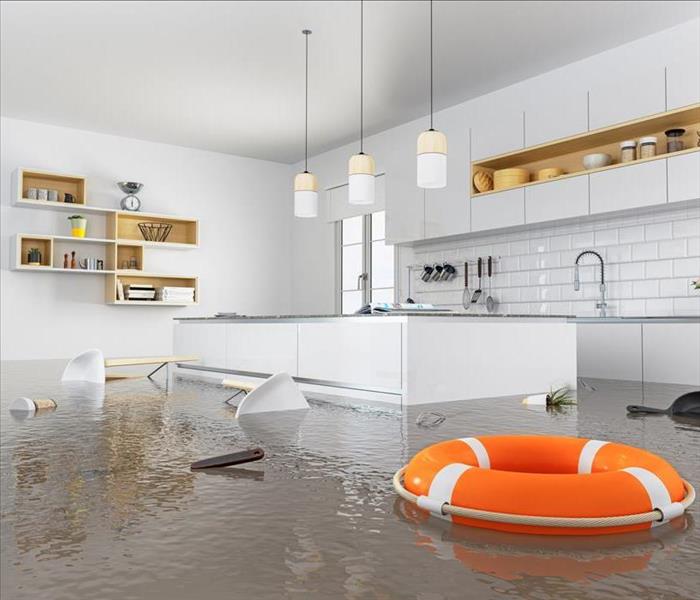What Qualifications Should I Look for When Hiring Flood Restoration Services?
5/19/2020 (Permalink)
The Institute of Inspection, Cleaning and Restoration Certifications (IICRC) is a Nationally Recognized Body for Restoration Standard setting. IICRC Accreditation Supports a Responsible, Honest Restoration Service for Companies in the West Hills Area.
How long does it take for the restorer to visit my property after arranging a service?
Reporting flood damage in your West Hills home is known as notification of loss. Notification of loss is essential to start restoration proceedings, and, until provided, there is a chance that the situation may become increasingly severe and time-consuming to restore. Once we receive the notification of loss, we can begin to put together the equipment, technicians, and crew chiefs that we need to recover flood losses at your home. We understand that quick call-out times are essential to reducing the amount of damage that a flood causes. SERVPRO promises to arrive at your property within four hours of notification of loss to begin emergency mitigation and services. At times, this may not be possible.
What can I do to secure a flooded property before technicians arrive?
- Prioritize personal safety above trying to prevent losses at all times
- Shut off power to the property thoroughly. Power can lead to fusing, electrical fires or circuit breaks
- Avoid using the plumbing system altogether. Shut and seal doors to rooms with open sewer points like kitchens, shower rooms, and bathrooms
- Gather essential items should you need to relocate from the property temporarily. These items could include identification documents, driving licenses, medicines or insurance paperwork
- Avoid close contact with floodwaters, which can contain high levels of contamination. Be aware that sewer gases, bacteria, and viruses can be present in floodwaters and are harmful to ingest or inhale.
How can I deal with building materials after contaminated water intrusion?
Blackwater intrusion can spread throughout your home, affecting carpets, walls, as well as furniture. In most situations, the restoration requirement is to remove any materials that make direct contact with the water. This can include the lower parts of the walls, including the baseboard. We may need to detach carpets and discard them as well as performing substantial disinfecting of the floor and subfloor. When we perform the invasive restoration, which involves removing building material, we document it in digital inventories to pass onto your insurer. However, we always try to salvage contents and building materials whenever possible.
How can I remove and dispose of building materials properly?
- Wear correct personal protective equipment including respiration masks to avoid ingesting dust or gases
- Inspect building materials for signs of cross-contamination. Items in direct contact with water are contaminated.
- Isolate sections of the building material and remove them up to two feet above the last water contact point
- Place contaminated materials into double sealable polyethylene waste bags
- Remove the offending items from the property.
- Pack the items onto a transport and dispose of them at a waste facility
Is the reinstallation of building materials covered within the cost of my claim?
Your insurer should cover the cost of your restoration from start to finish. Most policies stipulate that homeowners need to take adequate precautions to mitigate harm. However, in the case of a blackwater flooding situation, it is unlikely that the reinstallation of building materials is not included in your claim. SERVPRO water restoration technicians can begin to reinstall drywall, sheetrock, insulation, and other materials once dry out procedure is complete. We are not an insurance company and can only comments that may help your claims process.
Can I turn off drying equipment or open windows in the area where they are set up?
Ensuring that the drying process is efficient means controlling as many variables as possible. SERVPRO technicians may decide that the quickest method of drying an area is by using a closed system. Closed-system drying involves sealing a space from outdoor air and using dehumidification equipment to remove moisture from the environment. A closed-system drying process can take several days before we can remove equipment. By opening windows or shutting off equipment, you are slowing down the drying process and bringing in unknown variables that could lengthen the restoration. SERVPRO technicians return to a property regularly to measure drying effectiveness and ensure your property gets back to its preloss condition as quickly as possible.
Is your drying equipment going to increase my electricity bill?
Drying a property can help to limit secondary damages like mold growth. However, drying does take time, and in many cases, we may have to leave it overnight. We are always investing in eco-efficient drying equipment that does not use more power than necessary. However, we do need to use your mains electricity to power the equipment over several days. Some insurance providers do include this cost in your claim. SERVPRO calculates the electricity used during drying and can pass on the estimated cost of electricity to your insurer at your request.
Recovering a property from floodwater intrusion can be complicated and frustrating. Contact SERVPRO of Canoga Park / West Hills at (818) 998-1500 for a professional solution.

 24/7 Emergency Service
24/7 Emergency Service
